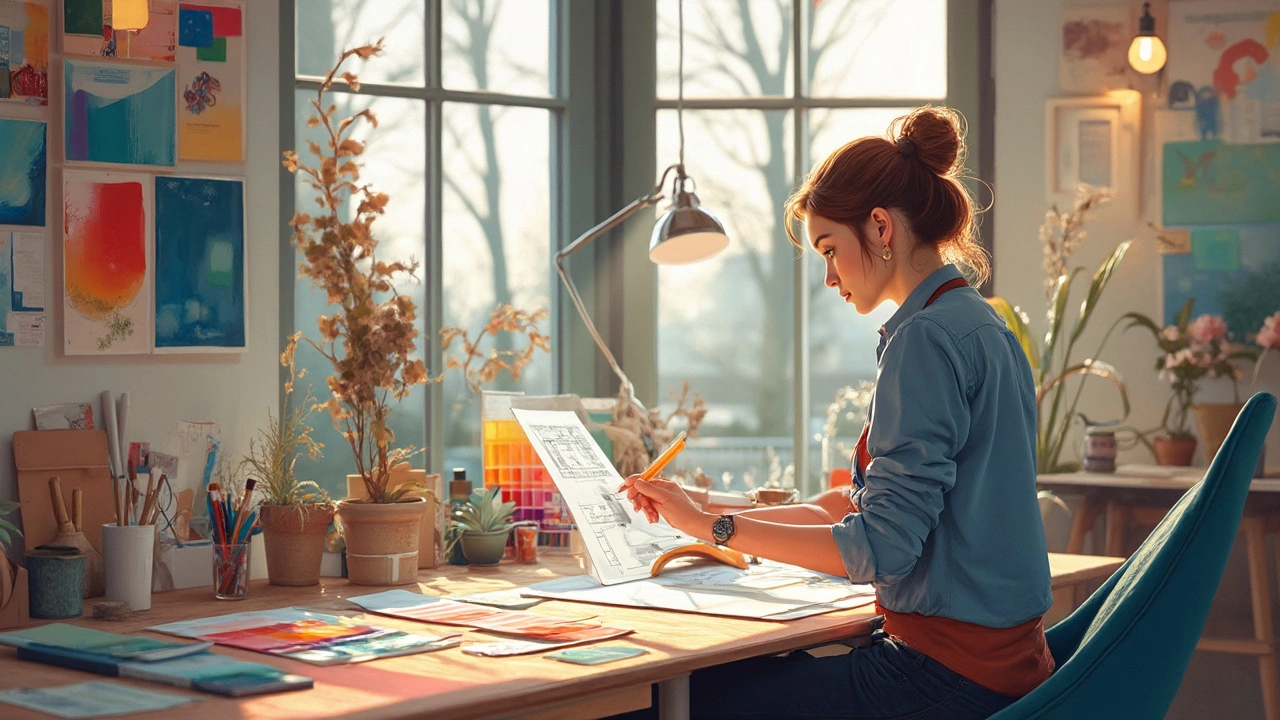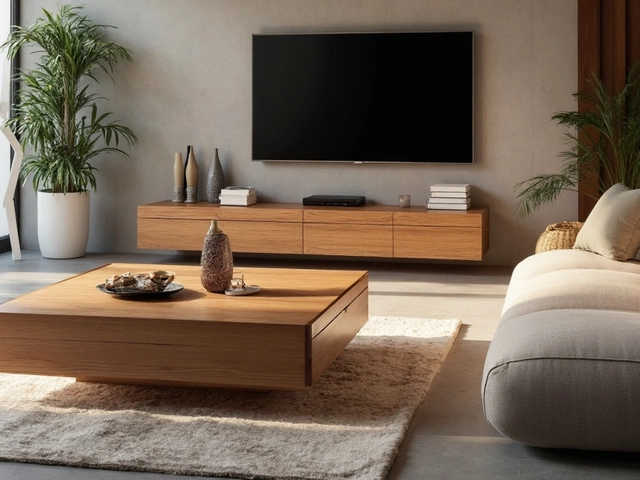
If you hear "interior designer" and picture yourself picking sofa colors all day, you’re missing most of the story. Real interior design is a mashup of creativity and problem-solving that goes way beyond picking out throw pillows. You’re juggling floor plans, budgets, client personalities, and a nonstop flow of decisions. Plus, not every space is glamorous—think offices, hospitals, even schools.
Plenty of people get lured in by the idea of turning Pinterest boards into reality, but the real work is more hands-on (and sometimes, downright stressful). Clients can be indecisive, contractors run late, and good taste isn’t always enough if you can’t also handle a spreadsheet. Want to know if the payoff is worth it? Stick around for the messy, honest details about actually working in interior design today.
- What Does an Interior Designer Actually Do?
- Day-to-Day Realities: Perks and Hassles
- Can You Make a Decent Living?
- Do You Need Credentials or a Degree?
- Is There Demand for New Designers?
- How to Know If It’s Right for You
What Does an Interior Designer Actually Do?
When you dig into what an interior designer actually does, it’s a lot more than making places look pretty. Designers are problem-solvers who balance how a space looks and feels with how it actually works for real people. Most days, you’re meeting with clients, measuring spaces, mocking up floor plans, choosing materials or furniture, and figuring out lighting—not just picking wall art.
The job often chunk down like this:
- Client meetings: Getting to know people, their tastes, and figuring out what they want versus what’s possible in their space or budget.
- Planning and drafting: Creating layouts using software like AutoCAD or SketchUp. You’re making sure that what a client dreams up can actually work—like, does that couch even fit?
- Material and product selection: From fabrics and tiles to lighting and furniture, you make the calls (within a client’s price range) and source the right stuff.
- Presentations: You pitch your ideas back to the client using mood boards, samples, or 3D renderings.
- Project coordination: Designing is one thing, but you also handle ordering, scheduling installations, communicating with contractors, and even chasing up deliveries.
The nitty-gritty stuff—like checking building codes, dealing with difficult clients, or making sure your design is wheelchair accessible—adds up fast. You can’t just wing it. In fact, according to the U.S. Bureau of Labor Statistics, about 30% of interior designers work for architectural or engineering firms—not just design studios or on their own.
Here's what an industry expert says:
"A great interior designer is equal parts artist, psychologist, and project manager." – Cindy Allen, Editor in Chief of Interior Design Magazine
If you like the idea of combining creativity with practical problem-solving, interior designer jobs might actually suit you well. But be ready to hustle—it’s not as chill as HGTV makes it look.
Day-to-Day Realities: Perks and Hassles
People think an interior designer spends the day sketching dream homes, but that's just one slice of the job. Real talk? You’re on your feet a lot, making site visits, talking to suppliers, and haggling over tile samples. You deal with tradespeople who sometimes forget what a deadline is—and clients who second-guess every decision.
On the bright side, this gig offers a ton of variety. One day you’re brainstorming a cozy restaurant vibe; the next you’re hunting for stain-resistant fabric for a family with toddlers. If you like solving puzzles and thinking on the fly, that’s a huge plus.
- Freedom of creativity: Most interior designers say the chance to help someone shape their space is addictive. You get to flex your taste, but also learn how to see through the client’s eyes.
- Never a dull moment: Design trends change fast. Clients, budgets, spaces—they all keep you guessing. You’ll almost never get bored.
- Business headaches: The downside? Designers have to chase payments, juggle paperwork, and sometimes pull all-nighters to meet deadlines. It isn’t all color palettes and inspiration boards.
There’s also pay to consider. According to the U.S. Bureau of Labor Statistics, the median wage for interior design jobs hovers around $61,000 a year. Top earners, especially in big cities or luxury markets, can make much more, but breaking in takes time and hustle.
| Perk | Reality Check |
|---|---|
| Creative variety | Comes with unpredictable hours |
| Client relationships | Requires patience and people skills |
| Flexibility | Most full-time roles still expect 40+ hours a week |
If you can handle the hustle and keep cool under stress, the perks balance the hassles. But you have to love more than just picking paint to stick with interior designer work for the long haul.
Can You Make a Decent Living?
Let’s talk money. Not everyone goes into interior design for a fat paycheck, but it’s natural to wonder if you’ll actually be able to pay the bills. The truth? Income in this field swings wildly. Where you live, the jobs you take, and how you build your reputation all matter more than you’d think.
The U.S. Bureau of Labor Statistics puts the median annual wage for interior designers at around $63,000 as of 2024. Designers just starting tend to land closer to $40,000, while those with years in the business or working for luxury clients can make over $100,000, sometimes a lot more if they have their own firm. Location makes a big difference—urban designers and those near wealthy markets earn the most, while small-town gigs pay less.
| Experience Level | Estimated Annual Pay |
|---|---|
| Entry Level (0-2 Years) | $37,000 - $48,000 |
| Mid-Career (3-7 Years) | $50,000 - $70,000 |
| Senior/Principal | $80,000 - $120,000+ |
| Self-Employed/Own Firm | $60,000 - $250,000+* |
*A few top designers take home much more, but it's rare. Reputation, client base, and marketing skills matter here.
It’s not a salaried 9-to-5 for most people. A lot of interior designer career paths mean working as a freelancer or consultant, and that means fluctuating income—some years are better than others. The unpredictable cash flow can be stressful, especially at the start.
If you want to boost your earnings, here’s what helps:
- Get good at project management and client communication. Happy clients give referrals, which brings more jobs.
- Specialize in a hot area—like sustainable design, office fit-outs, or luxury renovations. Niching down can mean higher pay.
- Keep learning about design trends and software. Tech skills help you stand out, especially with 3D modeling and virtual walkthroughs.
- Build a strong portfolio. Photos of your best work speak louder than diplomas.
New York designer Sophia Reeser sums it up best:
“This job definitely isn’t for people looking for easy paychecks, but if you love the work and hustle to get your name out, you can absolutely make a good living.”
So yeah, you can make a decent living in interior design, but expect some grind, especially while you’re building your reputation. It rewards hustle and strategic thinking way more than just having good taste.

Do You Need Credentials or a Degree?
This is where things get a bit tricky. If you’re hoping to stand out as a interior designer, having some kind of formal education definitely helps, but it’s not a hard rule everywhere. In the U.S., states like New York, Nevada, and Florida actually require a license to call yourself an "interior designer." That usually means passing the NCIDQ (National Council for Interior Design Qualification) exam. To even sit for the NCIDQ, you’ll need a mix of a design-related degree and at least two years of work experience.
So, do you have to have a bachelor’s degree in interior design? Not always. Some people get in with associate’s degrees or even certificates from accredited programs, but bigger firms and luxury clients still tend to look for a four-year degree. Architectural firms and hospitals almost always expect you to have the “real” credentials. If you skip the degree, expect to start out with smaller residential jobs or even staging model homes for realtors.
Here’s a breakdown of the usual options:
- Bachelor’s Degree (Interior Design): The "gold standard." Covers design principles, building codes, accessibility, software, and hands-on projects.
- Associate’s Degree or Certificate: Faster, cheaper, but usually means slower career growth. Works best if you’re planning to freelance or focus on residential jobs.
- Self-Taught/Online Courses: It’s possible, but you’ll need a killer portfolio and loads of hustle. No shortcuts here—clients will want proof you know your stuff.
If you want to move up fast or work on hotels, offices, or healthcare spaces, you need to learn commercial codes (like ADA and fire safety) and probably get licensed. No way around it. Some states even fine people for advertising as an “interior designer” without the paperwork.
| Credential | Typical Requirement | Best for |
|---|---|---|
| Bachelor’s Degree + NCIDQ | 4 years + exam | Commercial, bigger firms, high-paying jobs |
| Associate Degree/Certificate | 2 years | Freelancers, small residential projects |
| None (Self-Taught) | Portfolio, experience | Entry-level, side gigs, home staging |
One last thing: if you ever want to join the American Society of Interior Designers (ASID) or similar organizations, they’ll also want to see a relevant degree and work experience. If you’re aiming for a legit career in interior design, the more credentials you stack, the smoother your ride.
Is There Demand for New Designers?
You’ve probably heard mixed things about the job market for interior design, but here’s what’s happening in 2025. According to the U.S. Bureau of Labor Statistics, interior design jobs are expected to grow by about 4% this decade. That’s about average—not exploding, but definitely not shrinking. The catch? Design firms want more from new hires than ever before.
If you’ve got serious skills with design software like SketchUp or AutoCAD, and you’re comfortable managing projects, your odds are way better. Knowing sustainable design and smart home tech can also make you way more marketable. Commercial spaces and healthcare design are picking up, not just fancy homes. Businesses want designers who get branding, workplace wellness, and can balance budgets.
| Year | Number of U.S. Interior Designers | Average Salary |
|---|---|---|
| 2020 | 87,000 | $57,000 |
| 2025* | 91,000 (projected) | $62,000 (projected) |
*2025 numbers are projections based on recent industry data.
But—and this is important—a lot of people get into interior designer career because they love picking colors and furniture, not realizing how competitive it is. Breaking in can be tough without a strong portfolio or real-world experience. Internships, networking, and getting your work seen online make a real difference. New designers who hustle and keep up with trends land the best gigs.
If you’re flexible—think remote work, contract projects, or even starting out helping local businesses—the chances go up. There’s always space for creative thinkers who can keep clients happy and deliver results, especially if you’ve got tech skills or a design niche. The days of only decorating rich people’s houses are over. Offices, restaurants, healthcare spaces, and even retail stores are calling for help making spaces more comfortable, safe, and efficient.
How to Know If It’s Right for You
Before you quit your job and invest in design school, let’s get real about what it’s actually like to become an interior designer. This gig isn’t just for anyone who likes home makeovers. You need solid design sense, for sure, but there’s a lot more that goes into it.
Here’s a quick checklist to see if this career lines up with who you are and what you want:
- Creativity plus practicality: Can you come up with cool ideas and figure out how to make them work within real budgets and rules?
- Problem-solving under pressure: Deadlines get tight. Clients change their minds. Things will go wrong—can you stay calm and fix issues fast?
- Communication skills: You’ll talk with clients, contractors, and suppliers every day. If you hate explaining your ideas or negotiating, this might not be for you.
- Love of learning: Trends, codes, and tools change all the time. If you’re not into keeping up, this industry might leave you behind.
- Flexibility: Projects can run late. Sometimes you work weekends or evenings, depending on a client’s schedule.
About 62% of working designers say they spend more time dealing with logistics—like scheduling and budgeting—than actually designing, according to a 2024 North American Design Industry Report. If you’re hoping for non-stop creative work, you’ll be surprised.
It’s worth considering your personality, too. Do you like working solo, or do you prefer teamwork? Are you okay with a little chaos? Most interior designer jobs are heavy on collaboration, and even experienced folks say the job can feel unpredictable.
If you’re honestly excited by the idea of balancing creativity with problem-solving, and you don’t mind rolling with surprises, it could be a great fit. Internships or job shadowing can give you a taste of what it’s really like, without any huge commitment. Only you can decide if the mix of stress, challenge, and creativity is worth it—but if you love design and get a kick out of solving people’s space problems, you’re already on the right track.



